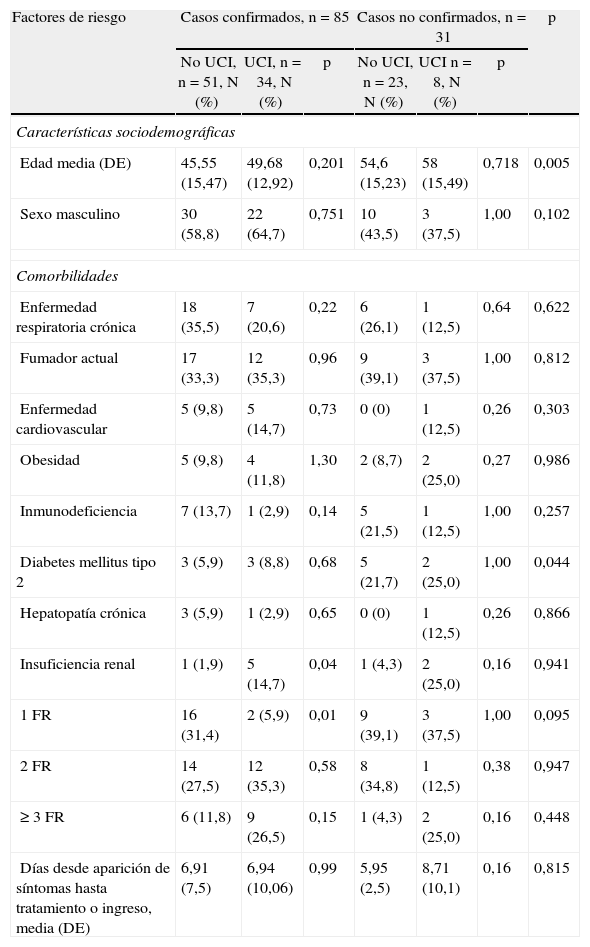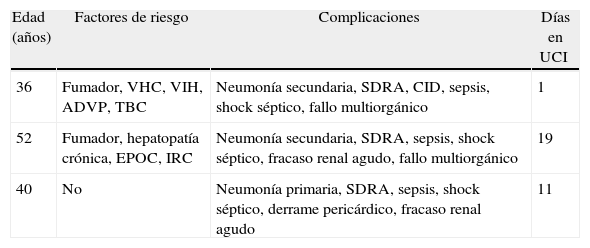Comparar características sociodemográficas y comorbilidad en pacientes hospitalizados en unidades de cuidados intensivos (UCI) o convencionales por sospecha de gripe A (H1N1) según confirmación microbiológica.
MétodosEstudio de cohortes prospectivo. Se incluyeron consecutivamente todos los pacientes ingresados en un hospital universitario de adultos, en unidades convencionales o UCI, con sospecha de gripe A (H1N1), entre el 1 de octubre 2009 y el 1 de febrero de 2010. Se registró información sociodemográfica, comorbilidades, evolución del paciente, tratamiento antiviral recibido y confirmación microbiológica mediante PCR en tiempo real. Se realizó un análisis descriptivo y bivariado según unidad de ingreso y confirmación microbiológica.
ResultadosCiento dieciséis pacientes con síntomas agudos de gripe A (H1N1) de 7 días de evolución (DE 1,15) fueron hospitalizados, con una edad media de 52 años (DE 5,5), mayoritariamente hombres (56%), con alguna comorbilidad (68%) como ser fumador, enfermedad pulmonar obstructiva crónica, enfermedad cardiovascular o insuficiencia renal. En 3 de cada 4 pacientes estudiados se confirmó microbiológicamente gripe A (H1N1) (73,3%), y el 36,2% fueron ingresados en UCI, falleciendo un 2,6%, siendo más jóvenes y con menos riesgo de padecer diabetes mellitus que los no confirmados. Todos recibieron oseltamivir iniciado en Urgencias, y un 80% recibió 150mg/12h durante un promedio de 10 días (DE 4,76). No se halló relación entre las variables estudiadas y el ingreso en UCI, excepto en los casos confirmados y con presencia de insuficiencia renal (p=0,04).
ConclusionesLa presencia de insuficiencia renal en pacientes confirmados que padecían gripe A (H1N1) incrementaba el riesgo de ingresar en UCI.
To compare the sociodemographic characteristics and comorbidity in patients hospitalized in intensive care (ICU) or conventional units for suspected influenza A (H1N1) depending on microbiological confirmation.
MethodsProspective cohort study. We included all patients consecutively admitted to an adult university hospital ICU or conventional units with suspected influenza A (H1N1) between October 1, 2009 and February 1, 2010. Sociodemographic information was recorded, comorbidities, patient outcomes, antiviral treatment, and laboratory confirmation of infection by real time PCR. A descriptive and bivariate analysis was performed according to admission unit and the microbiological confirmation.
ResultsA total of 116 patients with acute symptoms of influenza A (H1N1) of 7 days duration (SD 1.15) were hospitalised. The mean age of the sample was 52 years (SD 5.5), mostly male (56%) and with underlying comorbidity (68%) of smoking, chronic obstructive pulmonary disease, cardiovascular disease or kidney failure. The influenza A (H1N1) was confirmed in 3 out of 4 patients studied (73.3%), and only 36.2% were admitted to the ICU. The 2.6% who died were younger and had a lower risk of diabetes mellitus than non-microbiologically confirmed patients. All patients were started on oseltamivir in the emergency room, with 80% receiving 150mg/12h for a mean of 10 days (SD 4.76). No relationship was found between the study variables and ICU admission, except in confirmed cases and renal failure (P=.04).
ConclusionsThe presence of renal failure in patients who had confirmed influenza A (H1N1) increased the risk of admission to the ICU.
Artículo
Comprando el artículo el PDF del mismo podrá ser descargado
Precio 19,34 €
Comprar ahora







